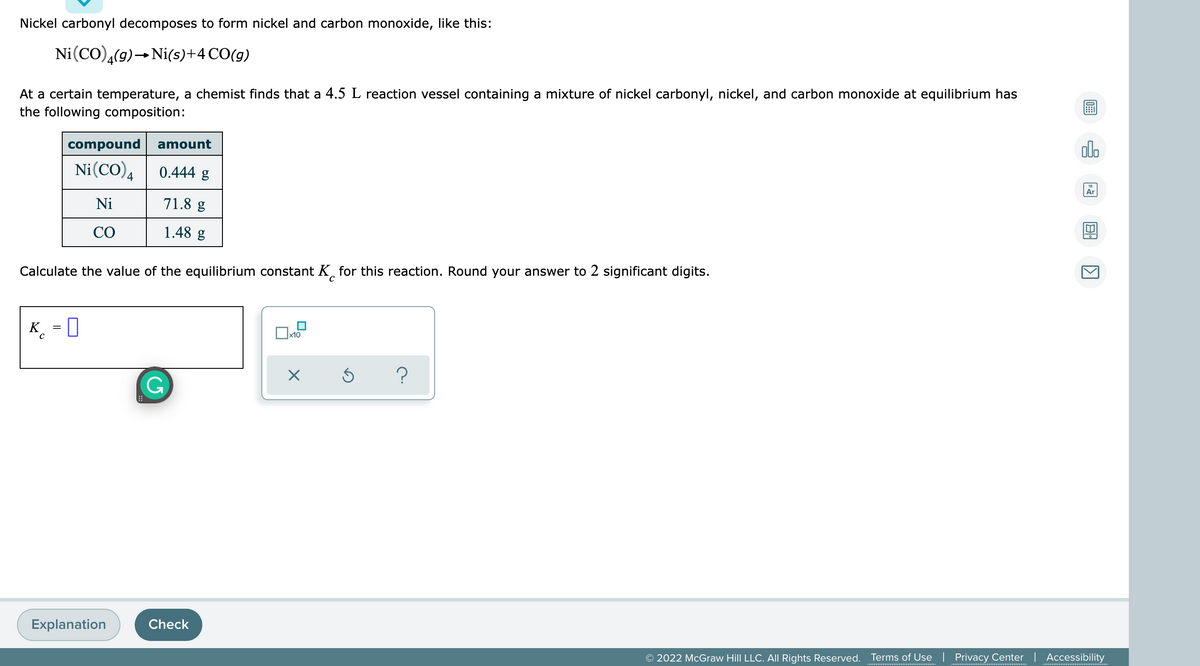Nickel carbonyl decomposes to form nickel and carbon monoxide, like this: Ni(CO),(9)→Ni(s)+4 CO(g) At a certain temperature, a chemist finds that a 4.5 L reaction vessel containing a mixture of nickel carbonyl, nickel, and carbon monoxide at equilibrium has the following composition: compound amount Ni(CO)4 0.444 g Ni 71.8 g CO 1.48 g Calculate the value of the equilibrium constant K for this reaction. Round your answer to 2 significant digits. K = 0
Nickel carbonyl decomposes to form nickel and carbon monoxide, like this: Ni(CO),(9)→Ni(s)+4 CO(g) At a certain temperature, a chemist finds that a 4.5 L reaction vessel containing a mixture of nickel carbonyl, nickel, and carbon monoxide at equilibrium has the following composition: compound amount Ni(CO)4 0.444 g Ni 71.8 g CO 1.48 g Calculate the value of the equilibrium constant K for this reaction. Round your answer to 2 significant digits. K = 0
Chemistry for Engineering Students
4th Edition
ISBN:9781337398909
Author:Lawrence S. Brown, Tom Holme
Publisher:Lawrence S. Brown, Tom Holme
Chapter12: Chemical Equilibrium
Section: Chapter Questions
Problem 12.37PAE: Again the experiment in Exercise 12.33 was redesigned. This time, 0.15 mol each of N, and O2 was...
Related questions
Question

Transcribed Image Text:Nickel carbonyl decomposes to form nickel and carbon monoxide, like this:
Ni(CO),(9)→ Ni(s)+4CO(g)
At a certain temperature, a chemist finds that a 4.5 L reaction vessel containing a mixture of nickel carbonyl, nickel, and carbon monoxide at equilibrium has
the following composition:
olo
compound
amount
Ni(CO)4
0.444 g
Ar
Ni
71.8 g
CO
1.48 g
Calculate the value of the equilibrium constant K, for this reaction. Round your answer to 2 significant digits.
K = 0
Explanation
Check
© 2022 McGraw Hill LLC. All Rights Reserved. Terms of Use | Privacy Center | Accessibility
Expert Solution
This question has been solved!
Explore an expertly crafted, step-by-step solution for a thorough understanding of key concepts.
This is a popular solution!
Trending now
This is a popular solution!
Step by step
Solved in 6 steps

Knowledge Booster
Learn more about
Need a deep-dive on the concept behind this application? Look no further. Learn more about this topic, chemistry and related others by exploring similar questions and additional content below.Recommended textbooks for you

Chemistry for Engineering Students
Chemistry
ISBN:
9781337398909
Author:
Lawrence S. Brown, Tom Holme
Publisher:
Cengage Learning

Chemistry & Chemical Reactivity
Chemistry
ISBN:
9781133949640
Author:
John C. Kotz, Paul M. Treichel, John Townsend, David Treichel
Publisher:
Cengage Learning

Chemistry & Chemical Reactivity
Chemistry
ISBN:
9781337399074
Author:
John C. Kotz, Paul M. Treichel, John Townsend, David Treichel
Publisher:
Cengage Learning

Chemistry for Engineering Students
Chemistry
ISBN:
9781337398909
Author:
Lawrence S. Brown, Tom Holme
Publisher:
Cengage Learning

Chemistry & Chemical Reactivity
Chemistry
ISBN:
9781133949640
Author:
John C. Kotz, Paul M. Treichel, John Townsend, David Treichel
Publisher:
Cengage Learning

Chemistry & Chemical Reactivity
Chemistry
ISBN:
9781337399074
Author:
John C. Kotz, Paul M. Treichel, John Townsend, David Treichel
Publisher:
Cengage Learning

Chemistry
Chemistry
ISBN:
9781305957404
Author:
Steven S. Zumdahl, Susan A. Zumdahl, Donald J. DeCoste
Publisher:
Cengage Learning

Chemistry: An Atoms First Approach
Chemistry
ISBN:
9781305079243
Author:
Steven S. Zumdahl, Susan A. Zumdahl
Publisher:
Cengage Learning
